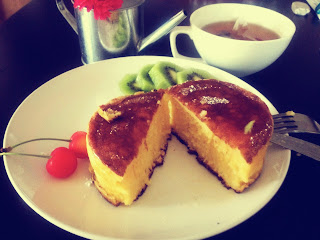I usually have very little time to cook in the evenings after work, and for dinner I'd just make something simple like a salad or stir fry. But last night I made a complete Nasi Lemak and Sambal Sotong dinner for my friends in a little under an hour and a half! I was near losing my mind in the process...
My brain:
Chop onions... Make sambal paste. Meanwhile, put the rice on. Where's the can opener for the coconut milk? Defrost the squid. Peel cucumbers... Boil eggs. Remember to put pandan in the rice. Fry anchovies while the sambal is cooking. Check sambal! Is the squid defrosting yet? Cool the eggs down. Where are the peanuts? Peel eggs and slice. Slice cucumbers.. Clean banana leaf. I forgot to add ginger to the rice!! Taste sambal. Add belacan? People are here already? Throw some keropok in the microwave! etc...
I'm still blown away if I think about how Ibu (our aunt) and grandmothers cooked in the kitchen. When I cook Malay food, I cheat. A LOT.
Authentic Malay cuisine is super labor and time intensive. The sambal (spicy sauce) takes about 45-60 minutes to cook properly, not including prep time to blend the tumis (sautée ingredients). There's no way I can do it without western kitchen cheats and without having a nervous breakdown.
Cheat List:
I blend the onions/shallots and garlic in a food processor, not by mortar and pestle.
I buy blended chilli (labeled as sambal oelek here in the US), instead of grinding my own chilli paste using dried or fresh (hard to find) red chillies.
 |
| Most likely on the shelf next to Sriracha sauce |
Buying frozen squid that is already cleaned. I just need to slice them. They also sell pre-sliced, frozen squid, but I stopped myself short of buying those. (There is a difference between small cheat and big cheat)
My coconut milk comes from a tin can. It takes 30 seconds to open a can of coconut milk. Real Malaysian housewives buy freshly grated coconut and squeeze the bajeesus cream out of it through a cheesecloth/strainer. Work those forearms, girl!
 |
| From this |
 |
| to this |
*See more photos on the whole process on this blog
here
 |
| Rich, fat, creamy version |
 |
| Light version |
I get spanish peanuts from the store (the kind that is roasted with skin ON). They are the closest thing to the real deal. No, I'm not roasting my own peanuts.
 |
| Pandan leaves |
Every decent Malay household, or every other house, cultivates a bush of pandan (*screwpine in English) in their back yard. Pandan is optional, since it's just an aromatic addition. However, small subtle details like this is what distinguishes the best Nasi Lemak from the so-so ones.
Now in Malaysia, you go to your back yard or holler at your neighbor prior to get some pandan from their yard... In the United States,
I buy a small vial of pandan essence. Try not to get the ones with green coloring in them (those are used for baking). Add 2-3 tiny drops.
 |
| Star Brand is a popular brand back home, I was lucky to find this at the Tai Nam Vietnamese grocery store. | | |
So there you have it. By Malaysian housewives standards, I didn't even cook at all...! Other than the sambal tumis sauce, all I did was just assembling ingredients together!!
The end result was still satisfactory. Although I always miss something when cooking the coconut rice, usually it's salt, but this time I forgot the ginger slices. My sambal is still a long ways from my grandmother's, which makes me frown a little bit every time :\











